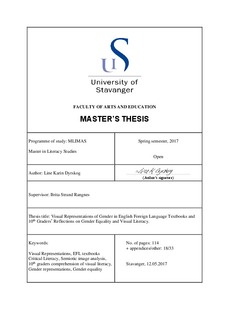| dc.description.abstract | This thesis presents a class of 10th graders ability to reflect on gender equality and visual representations, and how well four English Foreign Language (EFL) textbooks promote the Norwegian Curriculum’s general aim on gender equality through visual representations. These EFL textbooks were produced for lower secondary school, and were frequently used in EFL classrooms in Norway at the time that the study took place. Visual representations are known to communicate on the same premises as texts, and it has been argued that messages communicated through photographs are more likely to be accepted as truthful re-presentation of the world, compared to the written word. Thus, visual representations are believed by viewers to communicate objective messages. However, visual representations can be carriers of ideologies and myths on the same premises as written texts. As 10th graders are the targeted readers of the EFL textbooks, their abilities to analyse visual representations to reveal hidden meanings were investigated. They were also questioned on their thoughts and beliefs regarding gender equality in general, and also regarding the visual representations used in the EFL textbooks. This was done to investigate whether there were any differences to what the pupils were taught explicitly through their education, and what the visual representations might implicitly teach them. The information was gathered through questionnaires. A visual content analysis was conducted to gather information regarding the visual representations from the four EFL textbooks. This was based on coders created from the theoretical framework by Kress and van Leeuwen. These coders were ‘the gaze’, ‘vertical angle’, ‘horizontal angle’ and ‘size of frame’. The aim of the analysis was to investigate whether the visual representations supported or contradicted the general aim of promoting gender equality. Thus, categories as gender stereotyping, roles and occupations, power relationships and identification were also investigated. Visual representations of men and women were analysed through quantitative and qualitative semiotic analyses, and the results were compared. The results of the research on the 10th graders signified that there is a difference between what is explicitly taught through school, and what could be implicitly taught through visual representations. The 10th graders were positive and reflected when it came to gender equality in general, but they failed to draw connections to gender inequality being communicated through visual representations. However, the instruction given on semiotic analysis awakened a general interest for analysing visual representations, and the general concepts of Kress and van Leeuwen’s visual grammar were easily grasped by the pupils. Further instruction on critical literacy could benefit the pupils in their future life as citizens in an increasingly visual world. The visual content analysis revealed that there are still more visual representations of men compared to women in the four EFL textbooks investigated. Women are more frequently depicted in stereotypical roles, and are awarded less power than men. These results indicate that there are hidden ideologies and myths and these are communicated through the visual representations, which could be troubling for the 10th graders to identify with, as they contradict their beliefs on Norwegian society being gender equated. Subsequently, it could be argued that the results to a large degree contradict the general aim of LK06 to promote gender equality. | nb_NO |

